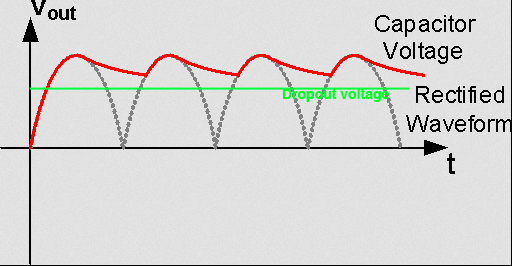With a 50Hz input and full-wave rectifier, the capacitor can be thought of as only being charged at the peaks of the 100Hz output of the full-wave rectifier. It then discharges during the 10msec before the next peak occurs.
The ripple is thus 10ms * I/C where I is the current at the input to the regulator (call it the output current + 5mA) and C is the input filter capacitance.
So if the output current is 100mA, then the ripple (peak to peak) will be 2.1Vp-p. A larger value capacitor will reduce the ripple.
If you assume the transformer has 9V output at 230VAC in, then the peak voltage will be about 10V with full line voltage, and maybe 9V with line voltage a bit lower than nominal. The 7805 needs a couple of volts to work well (probably more like 1.6V at 100mA) so it should be fine even if the line voltage is a bit low. See here for some graphics as shown below. Put 2uF in there, and it will be dropping out of regulation every half cycle (100 times a second). Draw 1A rather than 100mA, and the 470uF will be woefully inadequate.

The 0.01uF ceramic on the input is to lower the impedance of the 470uF at high frequencies. You can leave that out if the regulator is close to the capacitor but it does no harm. The 0.01uF ceramic on the output lowers the regulator output impedance to higher frequencies (aka improve transient response)- you'll want more than that close to the 8051, 0.1uF to 1uF is good.


